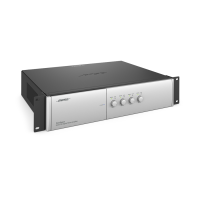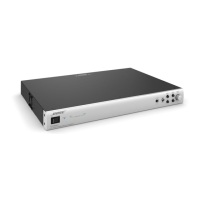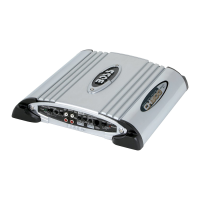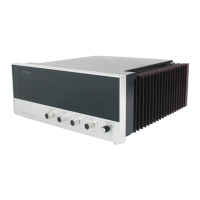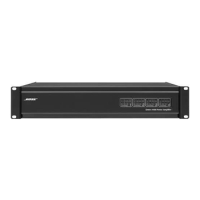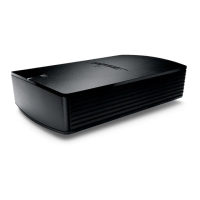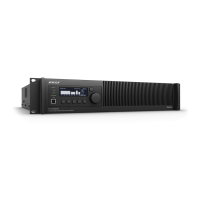63
Power Amplifier PCB (continued)
At approximately 90°C, the thermistor voltage at U425Ap4 exceeds the threshold at U425Ap5
and output U425Ap2 pulls to ground. Threshold voltage at U425Ap5 drops as the divider is re-
biased through R435 and D428, providing thermal hysteresis of ~5°C. The amplifier turns off
when C432 is discharged through D429, and “Thermal” LED D714 [Display PCB, D3] lights. As
the heatsink cools, thermistor voltage drops and comparator output U425p2 is pulled high,
allowing normal amplifier power up. Operation of the power transformer thermal cutout will
trigger the same thermal shutdown cycle.
When AC mains are disconnected by setting the power switch to “Off” or removing the se-
quence RCV potential, output turnoff transients are eliminated by muting the power stage before
the output and control rail voltages collapse. C435 [Signal Processor PCB sheet2, D2] is nor-
mally charged from the power transformer secondary through rectifier D403 and divider R458,
R452. When mains power is removed, C435 discharges rapidly, causing Q426 to discharge
control timing capacitor C432 through D431 and muting the power amplifier.
When the digital amplifier driver detects distortion on either channel, driver OVERLOAD output
U605p2 falls. This signal is buffered by Q601 [Amplifier PCB, C3], fed to the Signal Processor
Assy (J602p7 Power Amp Assy to J602p7 Signal Processor Assy), level shifted by comparator
U428C [Signal Processor PCB sheet2, G3] and output to ACM-1 interface J101p19 [B5/6].
Output Transformers
Note: Refer to the AC Input/Output PCB schematic sheet for the following information. The
designations inside the brackets “[ ]” indicate the grid coordinates for the component described.
The output transformers T601 and T602 couple the power amplifier to external loads, matching
power amplifier working impedance to multiple distributed-line impedances. At rated output
power, the amplifier drives 25V into the transformer primary [B3], which is stepped-up to deliver
distributed-line voltages of 25V (4.2 Ohm load), 35V (8.2 Ohm load), 50V (17 Ohm load), 70V (33
Ohm load) and 100V (67 Ohm load) as well as drive 4 Ohm and 8 Ohm voice coil taps. Multiple
output taps may be driven simultaneously so long as the amplifier is not loaded beyond rated
power capacity. Flat, full-range transformer frequency response maintains amplifier fidelity.
Transformer primary is driven from WL610, WL611 (Power Amplifier PCB); transformer second-
aries terminate to WL130-WL139 (AC Input/ Output PCB) where they run to CH1 output connec-
tor J102 [E3].
Display PCB
Note: Refer to the Display PCB schematic sheet for the following information. The designations
inside the brackets “[ ]” indicate the grid coordinates for the component described.
The display provides “Ready”, “Protect” and “Thermal” LEDs indicating amplifier status and
“Signal”, “-20dB”, “-12db”, “-6dB” and “Clip” LEDs tracking amplifier output level. A “Network”
LED indicates network activity when an ACM-1 input module is installed.
The “Signal” LED indicates presence of an input signal greater than -36dBu. The LED is driven
from the Signal Processor assembly (J700p16 Signal Processor Assy to P700p17 Display
Assy).
THEORY OF OPERATION

